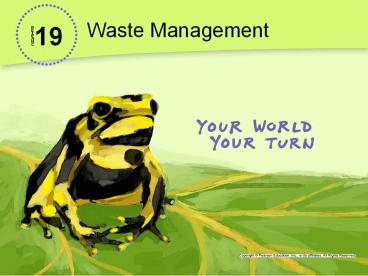Waste Management - PowerPoint PPT Presentation
1 / 19
Title: Waste Management
1
Waste Management
19
CHAPTER
2
Transforming New Yorks Fresh Kills Landfill
- Fresh Kills, on New Yorks Staten Island, is the
largest landfill in the world. - It closed in 2001, forcing New York City to find
other places for its trash, at great expense to
taxpayers. - Today the landfill is in the process of becoming
a public park.
3
Lesson 19.1 Municipal and Industrial Waste
- Of all the solid waste produced in the United
States, 33.9 is made up of paper.
4
What Is Waste?
Lesson 19.1 Municipal and Industrial Waste
Did You Know? The average American generates more
than 4.5 pounds of trash per day.
- Any unwanted material or substance that
results from a human activity or process - Municipal solid waste From homes and businesses
- Industrial waste Resulting from manufacturing,
agriculture, and mining - Hazardous waste Toxic, reactive, flammable,
and corrosive - Wastewater Includes used, discarded water
and runoff
5
Methods of Solid Waste Disposal Sanitary
Landfills
Lesson 19.1 Municipal and Industrial Waste
- Waste buried in the ground or carefully piled
into mounds - Designed to prevent groundwater contamination and
minimize soil and air pollution
Did You Know? Regulations require that landfills
be at least 6 m above the water table.
6
Benefits and Costs of Landfills
Lesson 19.1 Municipal and Industrial Waste
Benefits Costs
Decomposition yields methane, which can be used like natural gas. Leachate may eventually escape and contaminate the groundwater.
When full, landfills are capped. The land can be used for recreation. Trash decomposes very slowly.
Few communities are willing to host landfills (NIMBY).
A power company in Hull, Massachusetts installed
a large wind turbine on a site that had
previously been a landfill.
7
Incineration
Lesson 19.1 Municipal and Industrial Waste
8
Benefits and Cost of Incineration
Lesson 19.1 Municipal and Industrial Waste
Benefits Costs
Incinerating waste reduces its weight by up to 75 and volume by up to 90. Toxic ash must be disposed of.
Heat from burning trash can be used to generate electricity (waste-to-energy). Dioxins, heavy metals, and PCBs can be created and released by burning waste.
Toxic Substances Control Act Incinerator The only
U.S. facility permitted to burn certain hazardous
wastes
9
Lesson 19.2 Minimizing Solid Waste
- In 2007, Americans recycled or composted nearly
1/3 of municipal solid waste, saving energy
equivalent to 10 billion gallons of gas.
10
Waste Reduction Methods
Lesson 19.2 Minimizing Solid Waste
- Substitute disposable goods with reusable ones.
- Donate unwanted items.
- Minimize packaging.
- Reduce use of nonbiodegradable plastic.
- Design goods to last.
- Use financial incentives such as pay as you
throw garbage disposal and bottle bills.
Did You Know? States with bottle bills
(consumers receive a refund per returned bottle
or can) have reduced their beverage container
litter by 6984 and total litter by 3064.
11
Waste Recovery Composting
Lesson 19.2 Minimizing Solid Waste
- Conversion of organic waste into mulch or humus
by decomposition - Currently 3800 municipal programs in the U.S.
- Has many benefits, including soil enrichment
Did You Know? About 20 of U.S. waste is made up
of organic material that could be composted.
12
Waste Recovery Recycling
Lesson 19.2 Minimizing Solid Waste
- Collection and reprocessing of waste materials
- Recycling rates among U.S. communities vary from
5 to 50. - Many programs run at a financial loss, but that
doesnt take into account the effects of not
recycling.
13
Lesson 19.3 Hazardous Waste
- Common sources of hazardous waste include
batteries, cleaning agents, paints, and
pesticides.
14
What Is Hazardous Waste?
Lesson 19.3 Hazardous Waste
- Ignitable Can catch fire
- Corrosive Can damage or destroy metals
- Reactive Chemically unstable can explode or
produce fumes when combined with water - Toxic Harmful or fatal when inhaled, ingested,
or touched
15
Sources of Hazardous Waste
Lesson 19.3 Hazardous Waste
- Industry produces the most hazardous waste, but
it is usually highly regulated. - Household hazardous waste is unregulated.
Did You Know? The average American home contains
about 100 pounds of hazardous waste in different
products.
16
Types of Hazardous Waste
Lesson 19.3 Hazardous Waste
- Organic compounds Can act as mutagens,
carcinogens, teratogens, and endocrine disruptors - Heavy metals Many cause neurological damage over
time. - E-waste Contains heavy metals and toxic
chemicals, but mostly treated as conventional
solid waste
Did You Know? U.S. households threw out about 304
million electronic devices in 2005most were
still in working order.
17
Hazardous Waste Disposal
Lesson 19.3 Hazardous Waste
- Landfills Specifically designed to keep
hazardous waste contained - Surface impoundment Liquid waste poured into
shallow lined pits water evaporates and solid
waste is transported elsewhere - Deep-well injection (see diagram on right)
Wastes injected into deep, confined porous rock
layers
18
Radioactive Waste
Lesson 19.3 Hazardous Waste
- Waste that gives off harmful radiation
- Low-level Less harmful produced by hospitals,
labs, uranium mines - High-level More harmful produced by nuclear
power plants - Difficult to dispose of safely due to long
half-lives
Did You Know? As of March 2010, the Obama
administration has ruled out Yucca Mountain for
long-term storage of high-level radioactive waste.
19
Hazardous Waste Regulation
Lesson 19.3 Hazardous Waste
- Resource Conservation and Recovery Act (RCRA)
Sets standards for hazardous waste management by
states requires industry to track hazardous
material cradle to grave
- Comprehensive Environmental Response Compensation
and Liability Act (CERCLA), or Superfund Act
Federal program for cleaning up sites polluted
by hazardous waste culprits held liable for
damage caused by their pollution
Did You Know? As of 2007, 1354 of the 1569
Superfund sites have been cleaned up.































